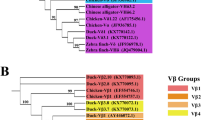Abstract.
The cDNA sequence of the delta T-cell receptor (TCRD) in the adult Lewis rat thymus was determined using the technique of rapid amplification of cDNA ends. Sixteen variable region genes (TCRDV), two diversity regions (TCRDD), two joining regions (TCRDJ), and a single constant region gene (TCRDC) were identified. The sixteen unique TCRDV genes identified represented eight different subfamilies in the rat and were highly conserved (>80% nucleotide identity) to corresponding mouse sequences. Extensive junctional diversity was observed in the rat, with both TCRDD regions (TCRDD1 and TCRDD2) utilized in the majority of cDNA clones identified. The two TCRDJ genes were highly conserved and corresponded to TCRDJ1 and TCRDJ2 in the mouse; the majority of clones utilized TCRDJ1. The TCRDC region in the rat was 91.1% identical to the mouse TCRDC gene and was highly conserved to other species. Although extensive sequence information about mouse gamma-delta T-cell receptor genes is available, current knowledge of rat gamma-delta T-cells is limited. The sequence analysis presented in this study adds to our understanding of gamma-delta T-cells in general, and it may be utilized to study the role of gamma-delta T-cells in immune-mediated disease and transplantation models previously established in the rat.
Similar content being viewed by others
Author information
Authors and Affiliations
Additional information
Electronic Publication
Rights and permissions
About this article
Cite this article
Watson, D., Ando, T. & Knight, J. Sequence and diversity of the rat delta T-cell receptor. Immunogenetics 51, 714–722 (2000). https://doi.org/10.1007/s002510000186
Received:
Revised:
Issue Date:
DOI: https://doi.org/10.1007/s002510000186




